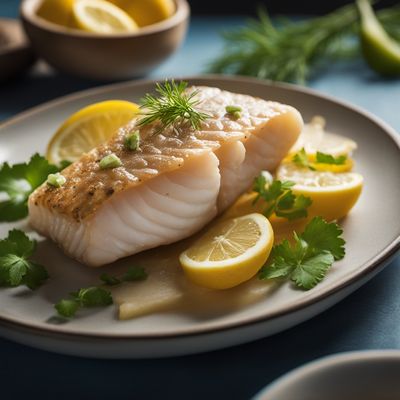
Ingredient
Cod, pacific
"The Ocean's Delight: Unveiling the Wonders of Pacific Cod"
Pacific Cod, scientifically known as Gadus macrocephalus, is a species of fish that belongs to the Gadidae family. It has a streamlined body with a distinctive chin barbel and a slightly arched back. The flesh of Pacific Cod is firm, lean, and flaky, making it ideal for a wide range of cooking methods. Its color ranges from white to pale pink, and it has a mild, delicate flavor with a hint of sweetness. The texture is tender yet firm, allowing it to hold its shape well during cooking.
Origins and history
Pacific Cod is native to the cold waters of the North Pacific Ocean, particularly the coastal regions of Alaska, Russia, and Japan. It has been a staple food source for indigenous communities in these areas for centuries. Pacific Cod has a rich historical significance, as it played a vital role in sustaining early explorers and settlers during their expeditions.
Nutritional information
Pacific Cod is a nutritious ingredient, rich in high-quality protein, omega-3 fatty acids, and essential minerals such as selenium and phosphorus. It is also low in calories and saturated fat, making it a healthy choice for those seeking a balanced diet.
Allergens
Pacific Cod may pose a risk for individuals with fish allergies.
How to select
When selecting Pacific Cod, look for fillets or whole fish that have a fresh, mild aroma and firm, translucent flesh. The skin should be shiny and free from blemishes or discoloration. Additionally, choose sustainably sourced Pacific Cod to support responsible fishing practices.
Storage recommendations
To maintain the freshness and quality of Pacific Cod, store it in the coldest part of your refrigerator, ideally at a temperature between 30°F (-1°C) and 34°F (1°C). Keep the fish wrapped in moisture-proof paper or plastic wrap to prevent it from drying out. Consume within 1-2 days of purchase for optimal taste and texture.
How to produce
Pacific Cod is typically harvested by commercial fishing vessels using trawling or longline methods. As an amateur, it is not feasible to produce Pacific Cod, as it requires specialized equipment and knowledge of deep-sea fishing techniques.
Preparation tips
Pacific Cod can be prepared using various cooking techniques such as baking, grilling, pan-frying, or steaming. It is often used in classic dishes like fish and chips, fish tacos, or fish stews. To enhance its flavor, marinate the fillets in citrus juices or season them with herbs and spices before cooking. Be cautious not to overcook Pacific Cod, as it can become dry and lose its delicate texture.
Substitutions
If Pacific Cod is not available, suitable substitutes include Atlantic Cod, Haddock, Pollock, or Halibut, which share similar characteristics and can be used interchangeably in most recipes.
Culinary uses
Pacific Cod is a versatile ingredient that can be used in a variety of culinary applications. It is commonly used in fish and chips, fish tacos, fish stews, and seafood soups. It can also be baked, grilled, or pan-fried and served as a main course with various sauces or accompaniments.
Availability
Pacific Cod is commonly available in North America, particularly in the coastal regions of Alaska and the Pacific Northwest. It is also cultivated and harvested in Russia and Japan.


